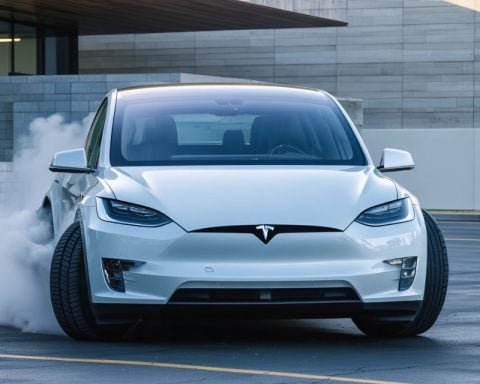- The 2019 Tesla Model S illustrates automotive progress, boasting an odometer of 250,000 miles.
- Charging from empty to full takes 2 hours and 41 minutes, with the slowest phase from 80% to 100%.
- The charging slowdown is due to the battery nearing full capacity and potential synchronization issues.
- The car quickly charges from 10% to 80% within 47 minutes, comparable to modern EV models like the Chevy Bolt.
- A top charge rate of 131 kW is modest today, but the Model S benefits from frequent, shorter recharges.
- Advancements in battery technology provide enhanced resilience and reliability for high-mileage EVs.
- This Tesla exemplifies both the potential and challenges of the electric vehicle revolution.
The sleek silhouette of a 2019 Tesla Model S stands as a testament to automotive evolution, its odometer reading a staggering 250,000 miles. Yet, beneath its futuristic facade lies a story of battery endurance that oscillates between optimism and sobering realism.
Charging this electric marvel from empty to full seemed to stretch into eternity—2 hours and 41 minutes to be precise. For those unfamiliar with the nuances of electric vehicles, such a time might appear prohibitive. However, delve deeper, and you’ll find a narrative far less bleak. The last stretch from 80% to 100% constitutes most of this marathon charge, a slow crawl that the initiated understand as the norm.
The reason? As a battery approaches full capacity, electrons scramble to find available parking, and if the battery management system falls out of sync, the process becomes even more tedious. This aged Tesla’s system required time to recalibrate, extending the already prolonged charge session.
Yet, dispelling the gloom, the Model S zipped through the bulk of its charge—from 10% to 80%—in a respectable 47 minutes. Comparatively, this performs similarly to newer, economy-driven models like the Chevy Bolt, which places this well-worn Tesla in good company.
While its top charge rate of 131 kW may be modest by today’s standards, the Model S compensates with a pragmatic charging strategy: frequent, brief recharges at a low state of charge.
Today’s batteries surpass those of yesteryear in both resilience and reliability, offering hopeful prospects for those considering a high-mileage EV. As each prospective owner contemplates their leap into the electric realm, this Tesla stands as a reminder of both the promise and the pragmatic realities carried by the EV revolution.
Unlocking the Full Potential of Your High-Mileage Tesla: A Comprehensive Guide
How-To Steps & Life Hacks for Efficient Charging
1. Optimize Your Charging Schedule: Charge your vehicle frequently but for shorter durations, particularly from a low state of charge to around 80%. This not only saves time but also reduces battery wear over time.
2. Use the Car’s Scheduled Departure Setting: This ensures your Tesla is preconditioned and fully charged at the exact time you plan to leave, increasing efficiency.
3. Avoid Charging to 100% Regularly: Only do this for long trips to preserve battery health and extend lifespan. Charging to 80% daily is ideal for most travel needs.
4. Regular Maintenance Checks: Ensure the battery management system is up-to-date and calibrated properly to prevent charging inaccuracies and inefficiencies.
5. Utilize Regenerative Braking: This helps recharge the battery during drive cycles, which can contribute to overall driving range.
Real-World Use Cases
– Long-Distance Commuters: A high-mileage Tesla Model S showcases the reliability of electric vehicles even over extended distances, proving viable for those with long daily commutes.
– Ride-Sharing Platforms: Companies like Uber and Lyft can leverage used Teslas as a cost-effective entry into EV ride-sharing, promoting sustainability and reducing operational costs.
– Fleet Management: Businesses can efficiently manage delivery routes with high-mileage EVs by optimizing charging and reducing fuel costs.
Market Forecasts & Industry Trends
The demand for electric vehicles continues to rise, with projections indicating a compound annual growth rate (CAGR) of over 20% in the coming decade. The focus on sustainability and the reduction of carbon footprints are key drivers of this trend.
Reviews & Comparisons
– Tesla Model S vs. Chevy Bolt: While the Tesla offers superior range and performance, the Chevy Bolt provides a more cost-effective, though less luxurious, alternative for shorter commutes.
– Battery Endurance: Newer models come with improved battery technologies providing faster charging times and longer life cycles.
Controversies & Limitations
– Battery Degradation: Over time, Tesla batteries can suffer from reduced capacity, which is more pronounced in high-mileage vehicles, though improvements continue to combat these effects.
– Charging Infrastructure: Inadequate charging infrastructure in certain areas can make long trips challenging, though this is steadily improving.
Features, Specs & Pricing
– Model S Range: Depending on the model and battery size, ranges typically fall between 300-370 miles on a full charge.
– Top Charging Rate: 250 kW for newer models, while older models usually top out at around 131 kW.
– Pricing: Pre-owned Model S vehicles can range from $30,000 to $50,000, depending on mileage and condition.
Security & Sustainability
– Tesla’s Autopilot and Safety Features: Equipped with top-level autonomous driving aids and safety measures to ensure passenger security.
– Sustainability: Tesla’s emphasis on eco-friendly manufacturing processes and renewable energy use sets a positive precedent in the automotive industry.
Insights & Predictions
As battery technologies advance, expect further reductions in charging times and increases in range. Initiatives in battery recycling will also improve, enhancing sustainability and environmental benefits.
Pros & Cons Overview
Pros:
– Long-lasting battery technology
– Lower running costs compared to conventional vehicles
– Extensive charging network for Teslas
Cons:
– High initial purchase cost
– Potential for battery degradation over time
– Longer charging times compared to fuel fill-ups
Actionable Recommendations
– Consider high-mileage Teslas as a viable option for cost-effective, sustainable transportation.
– Leverage Tesla’s robust Supercharger network for efficient trip planning and reduced charging durations.
– Stay updated on software upgrades that can enhance your EV’s performance and battery management.
For more exciting insights into Tesla and EV trends, visit the Tesla.



















